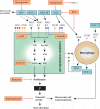Novel molecular pathways in Gorham disease: implications for treatment
- PMID: 24214028
- PMCID: PMC4123459
- DOI: 10.1002/pbc.24832
Novel molecular pathways in Gorham disease: implications for treatment
Abstract
Rapid advances in evidence-based treatment schedules are a hallmark of modern oncology. In rare neoplastic diseases, however, clinical expertise is hard to build and evidence based on randomized trials almost impossible to collect. Gorham disease is a rare form of lymphatic proliferation accompanied by osteolysis, which usually occurs in young adults. Despite the fact that the clinical course of Gorham disease is often devastating and occasionally fatal, insights into its biological background are sparse and standardized treatment unavailable. Interestingly, recent knowledge on the mechanisms of lymphangiogenesis may help elucidate the pathophysiology of Gorham disease and lead to novel treatment targets. Here, we discuss our current understanding of Gorham disease, discuss established and emerging therapeutic strategies, and attempt to frame a treatment rationale.
Keywords: Gorham disease; lymphangiogenesis; molecular biology; rare tumors; tumor biology; vascular malformations.
© 2013 Wiley Periodicals, Inc.
Figures

References
-
- Weiss SW, Goldblum JR. Enzinger and Weiss's Soft Tissue Tumors: Mosby Elsevier. 2008
-
- Blei F. Congenital lymphatic malformations. Annals of the New York Academy of Sciences. 2008;1131:185–194. - PubMed
-
- Fujiu K, Kanno R, Suzuki H, et al. Chylothorax associated with massive osteolysis (Gorham's syndrome). The Annals of thoracic surgery. 2002;73(6):1956–1957. - PubMed
-
- Tammela T, Alitalo K. Lymphangiogenesis: Molecular mechanisms and future promise. Cell. 2010;140(4):460–476. - PubMed
Publication types
MeSH terms
Substances
Grants and funding
LinkOut - more resources
Full Text Sources
Other Literature Sources

